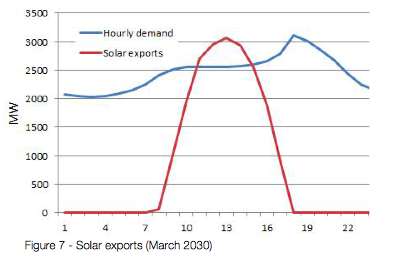A new report by a Western Australia academic has underlined the importance of grid-scale battery storage, particularly as the penetration of rooftop solar rises to the point where baseload generation will no longer be needed during the daytime. That scenario could arrive soon.
The report by Bill Grace – ominously titled Exploring the Death Spiral – looks at the WA grid, and the forecasts for rooftop solar and battery storage in coming years. He says rooftop solar will be irresistible because of its declining costs, so policy makers and utilities better get used to the idea and they need to plan accordingly.
“The inevitable increase in the take up of private solar PV systems in WA homes and businesses will hasten a transformation of the electricity network during the coming decade that is needed anyway,” says Grace, an adjunct professor who works at the Australian Urban Design Resource Centre.
Battery storage installed on the network is essential to maintain the stability and viability of the grid, and the good news is that it will ultimately result in lower overall costs than the base case that assumes no growth in renewables or rooftop solar. And, of course, it will result in lower emissions – a fall of 25 per cent under his scenario compared to a rise of 20 per cent in the base case.
 But the key, Grace says, is in centralised storage. Even large amounts of residential storage will not significantly deflect the major problem caused by rooftop solar- when its combined production will account for more than the entire demand in the state – meaning that baseload and other generators will have no market.
But the key, Grace says, is in centralised storage. Even large amounts of residential storage will not significantly deflect the major problem caused by rooftop solar- when its combined production will account for more than the entire demand in the state – meaning that baseload and other generators will have no market.
The report by Grace looks only at the WA grid – known as the South West Interconneted System, or SWIS, which is unique in the world in being an isolated grid serving a mature but rapidly growing economy.
As we have noted before, it is more vulnerable than any to the rapid technology changes that is making solar and storage more affordable. This vulnerability is increased by the massive subsidy ($600 million a year) in delivering fossil fuel electricity to customers, a situation that even the government says is unsustainable, and the absolute belief in policy makers that fossil fuels remain the future. See our story “The Madness of WA’s fossil flu energy disaster”.
The report by Grace is significant. He notes that despite some attempts to believe otherwise – such as the government-commissioned review which completely ignored renewables, and even canvassed the possibility of importing coal from Indonesia, the reliance on fossil fuels cannot continue, irrespective of the current political environment. That’s because there will be restrictions on emissions or rising fuel costs, or a combination of both.
And despite many arguing that the current over-capacity on the WA grid means there is no room more renewables on the network (an argument echoed in the national sphere), the growth of private solar is inevitable and will have major implications for the network irrespective.
“The energy system will change and … the inevitable increase in the take up of private solar PV systems in WA homes and businesses will merely hasten a transformation of the electricity network during the coming decade that is needed anyway,” he says.
Grace says – as many others have – that the days of the electricity industry being the sole provider of energy services to consumers are over.
“The industry must necessarily re-envision itself as a part provider of a service that (many) customers already partly have,” he writes. “In other words, they are competing with their customers and their response to this challenge will determine where the balance between network and private assets eventually lies.
“Policy must drive the most efficient economic outcome, not seek to “protect” the existing industry players. Lower emissions and lower total energy costs are positive outcomes for society and should be embraced, not resisted.”
 In his study Grace analyses a range of scenarios, including base case, a high solar penetration, and high storage penetration – which variations on whether this happens just in the homes, in businesses, or at the utility level.
In his study Grace analyses a range of scenarios, including base case, a high solar penetration, and high storage penetration – which variations on whether this happens just in the homes, in businesses, or at the utility level.
Right now, the SWIS is hugely dependent on fossil fuels, and has a generation capacity of 6,000MW, much of which lies redundant expect for a few peaks.
At the time of the study, only around 15 per cent of dwellings had solar PV with a total nameplate capacity of around 336 MW (this compares with 22 per cent in Queensland, with a total of more than 1GW).
Under Grace’s modelling, the fall in solar costs will result in 50 per cent of houses and 40 per cent of business having rooftop solar by 2035 (the grid operator has actually canvassed a much higher scenario, where up to 9,000MW of rooftop solar is installed by 2035.) Grace assumes an average rooftop array of 4.5kW for homes, and 90kW for business.
There are significant implications for the SWIS if this scale of growth in private solar PV occurs. By 2025 average hourly loads on the network are significantly reduced from the Base Case – and fall to zero in the middle of the day by 2030 – but maximum loads are only marginally reduced by daytime solar generation.
Storage payback periods in the model are dependent on storage costs, savings and REBS income which are all a function of solar array size. Accordingly it takes some time for paybacks to drop to the level whereby take-up would be financially attractive. However, after around 2020 paybacks have dropped to the 10-15 year range.
Penetration thereafter increases steadily in both residential and business facilities. By 2035 there is some 13,000 MWh of storage capacity and 405,000 houses and 45,000 businesses possess storage.
The addition of private energy storage does not change the quantity of energy generated, but it does reduce peak network demand. However, this is still only about 1.5 hours of storage at the nameplate solar capacity. It reduces, but does not eliminate, the periods of peak demand.
What really needs to happen, says Grace, is to introduce network storage into the SWIS. This could potentially occur at existing substation sites which dispatch and receive electricity from the private systems in homes and businesses.
Storage at this “downstream” scale would logically be complemented by larger scale storage “upstream” aimed at smoothing supply and demand from network generation. This would be part of a strategy to transition generation from fossil fuels to renewables.
 One of the interesting impacts is on costs. At a system level, the costs of the SWIS would be reduced with a high level of solar and storage, with private investment of between $11 and $15 billion offset by accrued savings on the grid of $7.6 billion. But the unit costs will rise.
One of the interesting impacts is on costs. At a system level, the costs of the SWIS would be reduced with a high level of solar and storage, with private investment of between $11 and $15 billion offset by accrued savings on the grid of $7.6 billion. But the unit costs will rise.
“Although reduced system costs indicate that increased solar penetration will lead to an overall economic benefit, a rise in unit costs is still problematical,” Grace writes.
“Individual consumers, who for one reason or other cannot reduce their network energy consumption sufficiently to offset tariff increases, will pay more for energy under this scenario. As this group will include those who are least able to absorb the additional cost, equity will become an important element of the policy response.”
If the introduction of storage within the network itself is commenced soon enough and with appropriate policy, it could potentially “head off” the growth in private storage modelled in this study.
“Economies of scale will mean lower costs per MWh for network scale storage, and if this was of sufficient scale to store all excess private solar generation, this could lead to the encouragement of solar while disincentivising private storage.”








